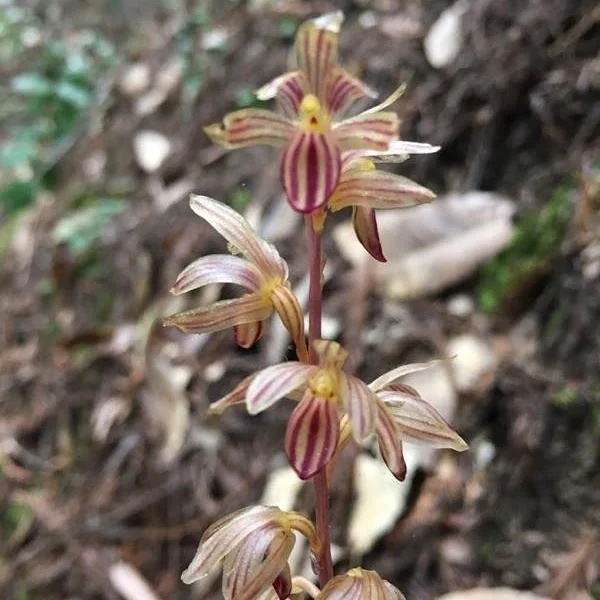Welcome back to the Our City Forest Blog. Today we have another guest post from Chad! I had great fun editing and expanding this post and I hope you enjoy it too.- Vincent
By Walter Siegmund - Own work, CC BY-SA 3.0,
Mist and petrichor, the smell of rain, the silent, distant movement of branches, stray sunlight strikes the trunks of giants. It’s morning in Big Basin State Park and I’m on a hike. Ancient sequoias bear burn scars from a recent fire. The call of birds and the buzzing of insects are muted among the pillars and ferns. An orchid grows inconspicuously in the shadowed underbrush. Leafless, striped white and blood-red, the orchid grows in rows of flower-bearing spikes.
No leaves. Only red flowers. By pverdonk CC 2.0 Non-Commercial
The red, mystery orchid was right along the trail, a 12-inch flower spike shooting right up from the soil. There were around 20 flowers going all the way up the spike. The lack of leaves was weird; what kind of plant doesn’t have leaves? Maybe this wasn’t an orchid but something else, something stranger. I snapped some pictures and continued my hike, keeping my eyes on the trail for more specimens but didn’t see any more.
The orchid family, Orchidaceae is enormous, containing 28,000 species. That’s just slightly more species than the population of Monterey, California. The species count does not include the 100,000 or so cultivars that have been bred by humans. California has only 31 native orchids (most of them live in the tropics). I didn’t realize that I had seen my first one.
Using The Power of the Internet I set out to discover the identity of the mystery plant. My first instinct, that it was, in fact, an orchid, was right. Our mystery plant is Corallorhiza striata, the striped coralroot. Striped coralroot is a parasite, a mycoheterotroph, a plant that parasitizes fungi. It was a mistake to look for green leaves. A parasite has no need for green leaves. They do not photosynthesize.
Mycoheterotrophs don’t just parasitize any fungi, they feed on mycorrhizae, the symbiotic fungi that enhance the growth of woody plants. Ironically, mycorrhizae likely started out as parasites themselves which makes our striped coralroot a parasite of a former-parasite-turned-symbiote. Simultaneously ingenious and obscure in a phyto-hipster sense, mycoheterotrophy is a niche niche; very few plants have managed to develop adaptations that allow them to parasitize symbiotic fungi. Many of them are orchids of the Neottia and Corallorhiza genuses.
Tylophilus, one of the many mycorrhizal fungi that can be parasitized coral root. (By Charles de Mille-Isles, CC 2.0 generic)
Orchid parasitism is probably related to a couple things. On one hand, symbiotic mycorrhizae tend to be indiscriminate in their symbiosis, bonding with multiple species and individual plants simultaneously. On the other hand orchids are all parasites of fungi at early life stages, relying on mycorrhizae for nitrogen and nutrients during germination. Put the two together and you have the ingredients for a parasitic relationship. After millions of years of coevolution with fungi some orchids retained their infant traits, never developing into photosynthetic life stages, forever reliant on the fungal network for sustenance.
This was one plant that I feel very lucky to have seen. You can only find them in the forest. Don’t expect to ever see this plant being sold at any nursery. Parasites, as it turns out, are incredibly difficult to cultivate and will never be grown commercially. The next time you are hiking in Big Basin or another dry, conifer-dominated forest, give your neck a break from looking upwards towards the tops of the sequoias and look down for small treasures like the striped coralroot.




